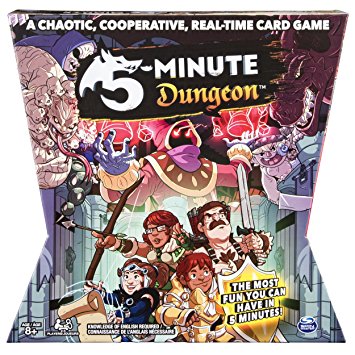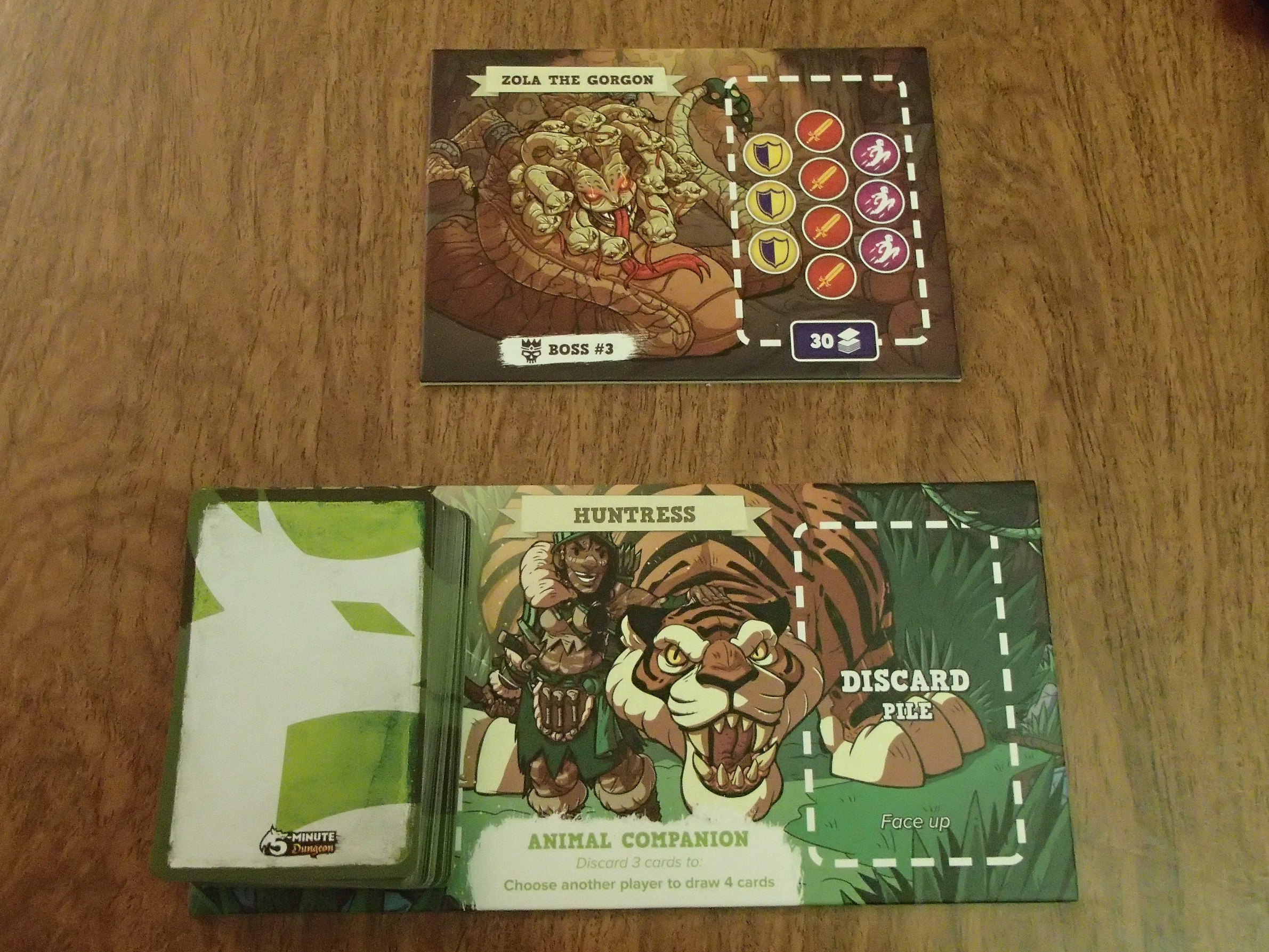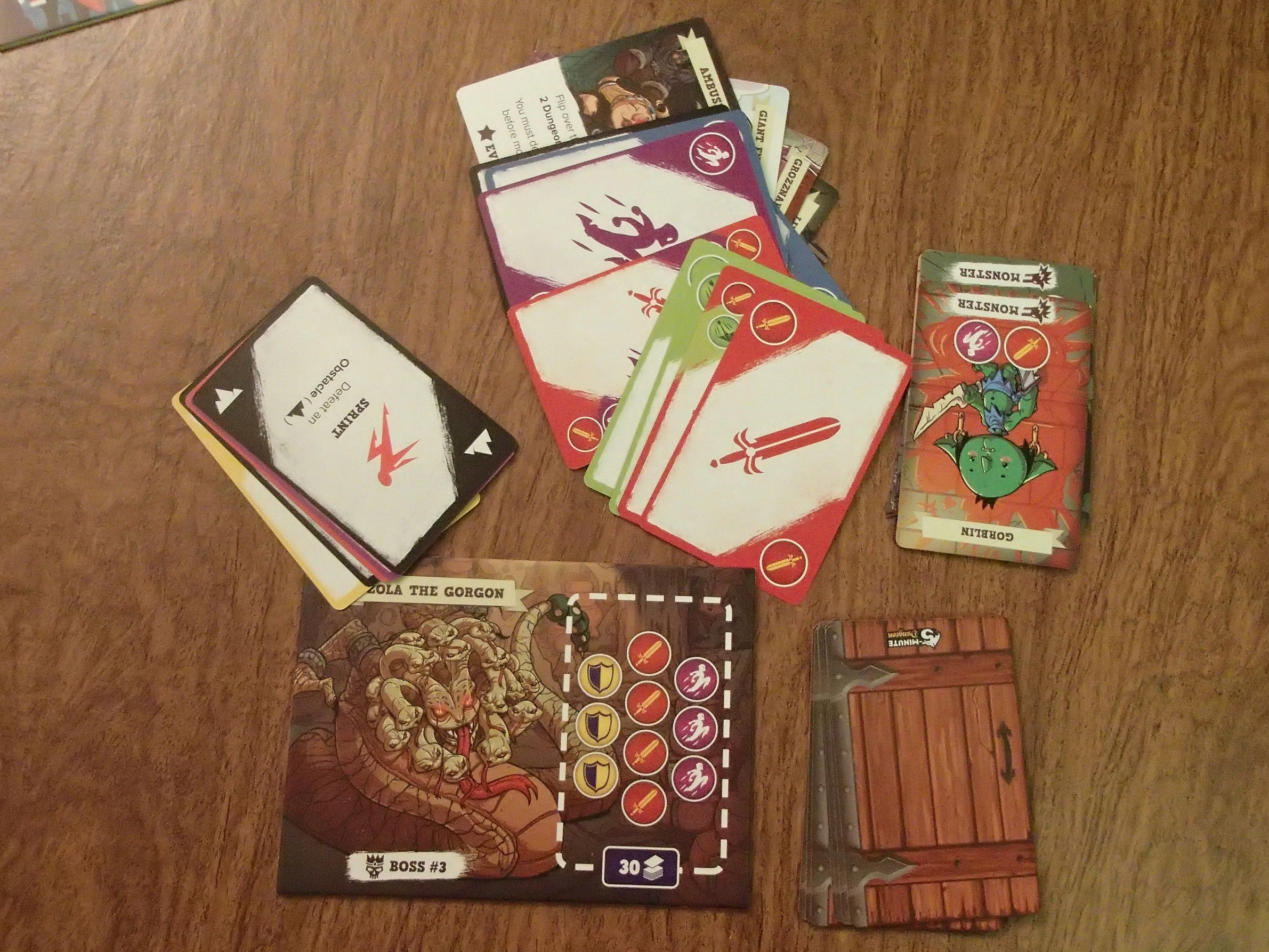| Publisher | Wiggles 3D, Spin Master |
| Design Credit | Connor Reid |
| Art Credits | Alex Diochon, Lorc, and Delapouite (http://game-icons.net) |
| Editing Credit | Peter Nesbitt |
| Game Contents | Five double-sided Hero boards in five colors; five matching colored decks (40 Hero cards each); five Boss boards; 40 Door cards; 10 Challenge cards; instructions |
| Guidelines | Cooperative dungeon-conquering game |
| MSRP | $19.99 |
| Reviewer | Andy Vetromile |
If a job’s worth doing it’s worth doing in five minutes, especially if that means not having to face horrible, fantastic creatures bent on eating you. Face it, the less time you spend in such ugly company, the better. Spin Master and Wiggles 3D are giving you the nickel tour of their tongue-in-cheek underworld with 5-Minute Dungeon, the fastest way to make a quick bag of gold.
The object is to complete the dungeon, in – surprise – five minutes or less.
Two to four players take on the roles of fantasy characters like Barbarian or Huntress. Each gets a Hero Mat and matching deck. The panels are two-sided so if one doesn’t like playing, say, the Ninja they can flip it to the thematically similar Thief side. The enemy, one of various creatures or beings with ill intent called the Boss, has his own board in the middle of the table sporting important game symbols like Scroll, Sword, and Shield. Stacked atop it is a facedown pile of Door Cards promising a variety of problems. Everyone pulls a starting “hand” of Hero Cards off their deck and the timer starts: five minutes to clear the lair.
Playing in real time, they flip a card out of the Door Deck and try to take each one down as it appears. So if the first one is an Adorable Slime displaying one Jump and an Arrow the players must, singly or as a group, play out Resource Cards showing those icons to defeat the creature or overcome the Obstacle. If they do, the next card is flipped to reveal another Dungeon denizen and the fight resumes. Each Hero Mat specializes in one of the symbols so if you need, say, Swords, all eyes turn to the Barbarian/Gladiator to provide them (or would if anyone dared lift their gaze that long from the tabletop). Others have these symbols too, just not in such rank profusion. The Dungeon “fights back” by not allowing the game to progress until someone can provide the right arrangement of maneuvers, or by exacting a penalty from everyone like the loss of their hand. Of, uh, cards.
Since the players cannot initially draw past their card limit (the more people participating, the lower the limit) success isn’t always easy, but the team has tools at its disposal. Every character has a power or ability, activated by discarding three cards, that bends the rules in some way. The Valkyrie discards cards so everyone else can pull extra cards past their card restraints, for example, while the Wizard freezes time – he pauses the timer and the party gets a breather wherein they can discuss strategy. Everyone’s deck is different and contains Action Cards like wildcards; abrupt “kill any monster” effects; or “healing” abilities that retrieve discards (those played against the Dungeon don’t come back but discards might).
If they survive to the end of the Door deck – and haven’t lost all their cards trying to beat back the hordes of lesser monsters – the Boss critter rears its fantastic head and must be defeated with a rather sizable pile of Resources. When – if – the team musters the necessary items they win and get to dance about on the graves of their enemies (and there’s probably some loot in there as well, at least in the abstract). Running out of cards or time means . . . resetting the timer and shuffling the cards for another go.
The cards aren’t as colorful or intricate as the characters “playing” them, but that’s okay – an Arrow card looks like an arrow and a Scroll is the same. Only if there’s text on it does the card bear further (and hopefully rapid) examination; the rest, you want them obvious and easy to recognize. Some Resources show two symbols in which case they can cover two requirements, though at the speeds they’re played it’s easy to overlook the paired icons in the corners of each card. The gorgeous illustrations continue the wink-and-a-nod feel of the game (and its endless pun artistry) with over-muscled hulks and winged warriors fairly bursting from the playmats. Various sources are strangely at odds about how many cards are in the decks (it’s 40 per character), and that’s if you can figure out which website is the “official” one for this game. The rulebook doesn’t even list the components.
As cute a look as the graphics achieve it doesn’t mean the game is juvenile. Kids will like it, sure, but so should any adults who enjoy any of the recent menu of timer-based games. It’s rapid and chaotic, as one might expect, but it’s a mostly manageable tangle with a bit of skill and strategy thrown in. As players learn their decks and abilities they get a better idea of what they can expect and how various characters interact, but there’s uncertainty sufficient in any layout to assure an uneven path to victory. (A path, by the way, that demands the usual roundtable arguments whether the game is even “doable.”) As the group progresses and likely excels, though, replayability may be a factor. This is in turn offset a bit by the fact that tracking cards is troublesome. Part of this is the nature of the beast – keeping your head while all other orcs around you are losing theirs – but even with the occasional time(r)-stopping Special Ability, remembering to draw/put cards from/in the discard vs. the Dungeon pile is a pain and midgame bookkeeping is a daunting task when you have to agree how many of the six to 12 cards you need have already been played.
There’s no timer included though you can download one tailored to this set to your phone with a variety of voiceovers (sorry, PC adherents, no love for you yet). Failure means you have to start over though the rules are unclear whether a rewind means going back to Dungeon #1 or just reliving the most recent embarrassment (presumably they leave it to players to dictate their own frustration level). 5-Minute Dungeon is faster than most entries in this field and its clear and intuitive rules (you can pick most of it up by watching another group play through it for five minutes) mean little time is wasted getting up to speed or arguing over interpretations. It’s a solid five minutes of fun spent spitting at each other as it was intended, followed by another five of either progressing to and setting up the next level or taking a mulligan on another dismal outcome.



